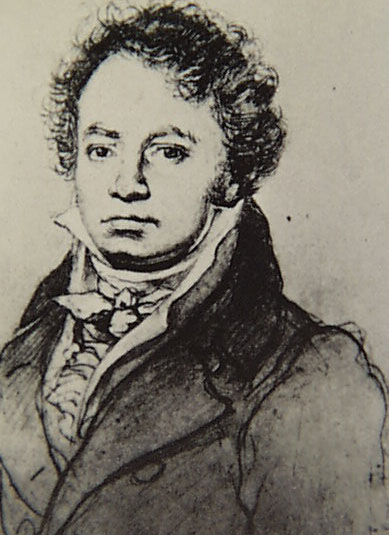Blogging all Beethoven’s symphonies here (one more to go!) in sequence helped me gain some more understanding of this great genius, one aspect of which is the vast variety and originality of his works. One after another, each symphony is so drastically different from both its predecessor and successor; it’s simply impossible for us not to be astonished by such endless creativity and intellectual power!

Beethoven portrait by Louis Letronne in 1814
In his interview given to UE’s Conductor’s Interview series on Gustav Mahler, Daniel Barenboim said that most wonderful thing about Mahler’s symphonies is that as if Mahler looked for and found a different idiom for each of his symphonies…few composers can do that, and Beethoven is one of them: one would listen to his Fifth and Pastoral and think they were written by two different composers! (he didn’t think we could say that about Brahms, Bruckner or Schumann)[1].
Beethoven completed the Eighth in the summer of 1812, the same year as his Seventh, yet the work presents itself with a drastically different style from its predecessor. George Grove made the point very clearly: this Symphony is certainly entirely different from No. 7; but then is not every Symphony and every movement of every Symphony of Beethoven entirely different from every other one?[2]
1. Allegro vivace e con brio
The opening starts by the full orchestra and straight into the main theme, without a single bar of introduction (as opposed to his First, Second, Fourth and Seventh), a grand and glorious entrance:
A delightful second theme flows on the strings shortly after:
The entire movement develops mostly around the main theme. And here is how the coda reaches its climax and then rapidly calms down, and in a most ingenious creative move, ends the movement quietly with the very first six notes of the opening:
2. Allegretto scherzando
The second movement opens with a beautiful light-hearted melody (first subject) on the strings, with its witty and humorous tone emphasized by the “tapping” chords on the woodwinds:
the second subject extends more of such fun:
This is the shortest of all Beethoven’s slow movements.
3. Tempo di menuetto
Here comes another unusual movement, Beethoven brings us back to the classic Minuet & Trio instead of a Scherzo. Here’s the warm and charming Minuet subject, played gracefully by the strings:
Of course Beethoven won’t just follow this antique form exactly as tradition calls, for starters the first note starts on the ending up beat of first measure, and rhythmic irregularities (such as off-beat accents and syncopation) can be heard all over the movement.
The sweet middle section is led by the horns and then extended by clarinet:
4. Allegro vivace
The fast and joyful Finale starts lightly with the first subject on the strings, then suddenly burst into full force (fortissimo) by the whole orchestra:
The subject elaborates with many unexpected sudden shifts of dynamics and rhythms, again showing Beethoven’s many playful tricks.
Contrasting with the above is the relaxed second subject:
It is without doubt that this Symphony is the most bright and joyful of all Beethoven symphonies. As Grove puts it, the whole work overflows with humor…no composition of his reflects more obviously the love of rough fun, and bursts of laughter which were so characteristic of him, than this[3].
[1] UE Mahler Interview with Daniel Barenboim, from Youtube.com
[2][3] Grove, George: Beethoven’s Nine Symphonies – Analytical Essays. Boston, 1888.

